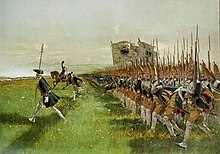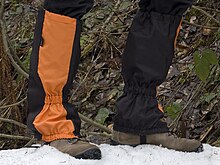spat

A gaiter is a garment that is attached to the footwear and covers parts of the foot and leg - sometimes over the knee.
Gaiters can be made of cloth , canvas , plastic or leather , can be wrapped, tied on the side or buttoned. They should protect against injuries, dirt, cold and moisture and - in a more solid version with ankle-free shoes - stabilize the ankle area. In the past, gaiters were mainly used in the military and are still used today in various sports and on horses.
etymology
The term was originally the Spanish name for a specific type of leather, gaudamaci . This word goes back to the Arabic ǧild ġadāmisī , which means “leather from Ghadames ”. In the 17th century, the term was adopted as gamache in French and then flowed into German usage.
Colloquially, gauntlet service has been retained as a synonym for a pedantic , petty service without any recognizable meaning.
Military clothing
White or black-dyed linen gaiters were part of the uniform of the foot troops in most western armies in the 18th and early 19th centuries . These gaiters, which were held in front of the heel of the shoe sole with a fabric or leather bar, were either buttoned up over the pants as a knee-length version or wore a shortened form under the trouser legs - especially during and after the coalition wars. Unmounted officers initially wore gaiters, but were given boots from around 1780 . In the course of the first half of the 19th century, gaiters, at least in the knee-length version, went out of use in many countries and only reappeared in a different form in the second half of the 19th century. From then on, the bar was mostly missing, which fixed the gaiters, which are now often made of leather, on the foot. During this time, they were used like an "extension" of the mostly ankle-high military lace-up boots that could be closed with leather laces or - for example in the Prussian and Russian armies - were completely displaced by knee-high knobs .
But even in the 20th century, variously manufactured calf-high cloth and leather gaiters were part of the military equipment of many armies in the First World War . Wrap gaiters were completely different in shape, but identical in function . These were first used in particular by Great Britain (since the introduction of the khaki uniform from 1902) and then France. In the course of the First World War, functional considerations and a drastic lack of material led to a partial takeover by the German armed forces. Wrap gaiters, unlike normal gaiters, were even used by mounted units. All kinds of gaiters were found in many armies during World War II . Over time, gaiters disappeared as a component of field and work suits in most armed forces and are now only found in parade uniforms , if at all . Some paramilitary police associations, such as the Federal Border Police, like the Wehrmacht, used short ankle-high canvas gaiters until the uniform was changed in 1976. In its founding phase, the Bundeswehr followed the American model very quickly with lace-up boots that had sewn-on leather gaiters. Since this did not prove itself, those responsible returned after a year, in addition to the Knobelbechern , to the lace-up shoes with short canvas gaiters that had been worn by the German military for a long time. It was only with the introduction of the combat shoe model 1971 that the Knobelbecher, but also the lace-up shoes with gaiters, were replaced. Today some units of the Bundeswehr wear high flecktarn gaiters with Velcro fasteners as protection against moisture .
Civil clothing

In the civilian sector, the greatly shortened gaiter with a bar, which barely covered the ankle, was a fashionable accessory of the Biedermeier era , which was particularly valued by elegant men. The button closure on these models was attached to the side. These gaiters were worn with ankle-length trousers.
After that, gaiters were largely forgotten as a fashion accessory, only to be reintroduced as an integral part of the cutaway from 1900 , this time in a version made of heavy white wool with a soft inside. The summer jacket included short, champagne-colored gaiters with leather straps and matching models made of coarse wool went with the winter suit. There was also a special gaiter for sporting activities. In principle, the gaiters were only worn with a day suit and with ankle-length, mostly turn-up trousers, such as a calf-length version between 1915 and 1917 with the war crinoline . After the first half of the 1920s, gaiters initially lost their position in the fashion sector. But already in the period after 1930 it reappeared, now as an accessory to the striped trousers.
In the second half of the 1960s, gaiters were offered in knee-length models with mini-length coats. The emerging at the beginning of the 1980s and until today still often in ballet or aerobics worn Legwarmers leggings can be regarded as knitted variant.
Osh
In the field of occupational safety, leather gaiters are used for welding. They serve as foot protection to prevent burns on the feet from splashing sparks. Here the gaiter is strapped around the lower leg from the front. A long foot sheet protects the lacing on the shoe and a web under the sole holds the gaiter in position.
Sports and casual wear
The gaiter became popular in sports and leisure from 1900. Hunting parties wore long and medium-length models, as well as knee-length cloth leggings. Even with the German Boy Scout Association , founded in 1911, knee-high, reed-green cloth leggings with side lacing were worn in many local groups until the early 1920s.
To protect against dirt, moisture and cold, gaiters are still in use today in cycling , skiing , mountaineering and hiking . They also offer some protection against ticks . In expedition mountaineering, special expedition gaiters also serve to isolate the lower legs and feet. The insulation is done by closed-cell insulation foam. Expedition gaiters thus make it possible to use ordinary, normally insulated and crampon-compatible mountain boots for mountaineering in much colder regions. There are now expedition shoes for high-altitude mountaineering that have integrated gaiters.
Horse equipment
Gaiters are also used in various designs to protect the horse's leg, in particular the cannon bone , the fetlock and the tendons when riding or driving . Gaiters are particularly popular in show jumping and cross-country sports to reduce the risk of injury when overcoming obstacles. The materials used are leather , fur and, increasingly, various plastics , especially neoprene . The English term splint boots is used in western riding .
literature
- Laurent Mirouze: Infantrymen of the First World War . Dißberger, Düsseldorf 1990, ISBN 3-924753-28-8 .
- Laurent Mirouze, Stéphane Dekerle: The French Army in the First World War. March 1914 . Vol. 1: Uniforms - Equipment - Armament . Verlag Militaria, Vienna 2007, ISBN 978-3-902526-08-3 .
- Otto von Pivka , GA Embleton: Napoleon's German Allies . Parts 2-5, Osprey Publishing Limited, London 1991, Part 2: ISBN 0-850452554 .
- Ingrid Loschek : Reclams Mode and Costume Lexicon , Verlag Philipp Reclam jun., Stuttgart 2005, ISBN 3-15-010577-3
- Ludmila Kybalova, Olga Herbenova, Milena Lamariva: The large picture lexicon of fashion - From antiquity to the present , Artia Verlag, Prague 1966. ISBN 978-3-570-03026-4 .



